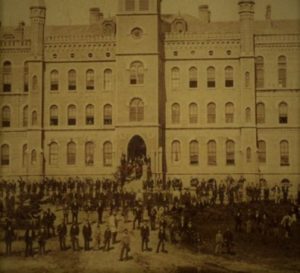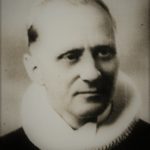During the last decades of the 19th century, population growth in North America was greater than ever before. Immigration from Europe resulted in new regions being settled both in the United States and Canada. New town and cities developed at unprecedented speed. New, young societies were developing in both countries; opportunities to make a better living than in the old countries were many and diverse. Most immigrants brought with them experience and knowledge which they hoped to build on in their new home in North America. Their children, born and brought up in the new land, grew up in times of new discoveries and progress. Icelandic parents in North America wanted the best for their children and early they realized that the key to success in America was good command of the English language which made education easier. In the Icelandic settlements in North Dakota, settlers made every effort to establish schools in their settlements and villages. The teachers often were young Icelandic students who had some higher education for example from the University of N. Dakota in Grand Forks. These without doubt had a part in the decision of some of their students to follow suit rather than hard work in fields for the rest of their life. In her book “Saga Íslendinga í N. Dakota” Þórstína Þorleifsdóttir mentions a few young men who either became medical doctors or lawyers. One such was Hjálmar Ágúst Eiríksson Bergman who was born in Garðar. Let‘s look at what she said among other things.

Norwegian Luther College, Decorah, Iowa
Education-occupation “Hjálmar Ágúst Bergmann was born in 1881 in Garðar in North Dakota. His parents were Eiríkur Hjálmarsson Bergman and Ingibjörg Pétursdóttir Thorlacius. Hjálmar received his public school education in N. Dakota but higher education at Luther College in Decorah, Iowa, where he graduated with a B.A. degree in 1900. He studied Law at the University of N. Dakota in Grand Forks, graduating in 1903 with a LL.B and in 1906 from the University of Manitoba with another LL.B for the province of Manitoba. Thus he is licenced to work in North Dakota and Manitoba. On October 6, 1920, Hjalmar was made “King’s Counsel” which is a special honor in the British Commonwealth for outstanding accomplishments in the field of Law. With this reward, lawyers can bring cases to court of Law as well as defend clients which occur in their Provinces without having to apply for such rights. This great honor brought various fringe benefits of great value to the practicing lawyer. Only one other Icelander has thus been honored, Thomas H. Johnson, former Minister of Justice in Manitoba. Hjálmar has taken many cases to court which have caught public attention, three of which concern not only the Icelandic community in North America but also in Iceland. One was the so-called Case of Thingvalla Church from 1910-1914, second was the Tjaldbúða case and the third was the defense for Ingólfur Ingólfsson. Bergmann was the plaintiff’s lawyer in the first two, he personally argued the cases. He won both. The last case caught the most attention, mainly because Ingólfur Ingólfsson was the first Icelander in North America charged with murder, the first Icelander charged for such a crime. (This happened in Alberta in Canada. Ingólfur was sentenced in 1924 for beating one Hugh McDermott to death. Ins. Jónas Thor) Ingólfur was found guilty and sentenced to death, when Bergmann took the case. The sentence was based on probabilities, and some Icelanders who followed the case in court felt the defense had been very poor, so the Icelandic National League in North America started a fund-raising project to cover costs for reopening of the case. Hjálmar was hired to defend this unfortunate man. Those familiar with the British Justice System know that it is anything but easy to reverse sentences once passed in court. But Hjálmar managed, after considerable work and research, to change the sentence to life imprisonment. Icelanders, both in the United States and Canada, took this case much to heart, especially because not one Icelander in North America had been sentenced in criminal court in their 50-year-old history on the continent. They were therefore very grateful to Hjalmar for making it possible for one of their own to be saved from the gallows. Hjálmar’s main characteristic is excellent workmanship, nothing is too much effort if it supports his case regardless of its significance in the beginning. According to Rev. Friðrik Bergman, his cousin Hjálmar Bergmann is one of the very few Icelanders born in North America to be bilingual, i.e., can express himself with ease in both Icelandic and English. Hjálmar Bergmann is married to Emilía Sigurbjörg Jónsdóttir, daughter of Jón Jónsson Bardal, farmer in Garðar.

Séra Valdimar Eylands Photo: UVTV
Another murder case: Icelanders in North America sometimes turned to Hjálmar Á. Bergmann and sought his help when legal advice was needed. Rev. Valdimar J. Eylands told me about one such case. I (J. Th) was a student at the University of Manitoba in Winnipeg during 1977-1980 and chose to use the available space in the Icelandic section of the library. Rev. Valdimar J. Eylands frequently did the same as he worked on his book, “Úr Víðidal til Vesturheims”. We sometimes went for coffee together and chatted. The pastor was most informative and a pleasure to listen to. Once he told me about the most difficult case he ever faced as a pastor in Canada. He was called to a prison where those condemned to death awaited their execution. A middle-aged man had been found guilty of the murder of a young woman and sentenced to death. This man was Icelandic and therefore a request for an Icelandic pastor was sent. I do not name the man, in 1900 he came to Canada at the age of two with his parents. Curious, I read the case and found the following: .. “a bachelor born in Iceland who at the age of two arrived at the Lake Manitoba Narrows with his parents. In winter, N. fished on Lake Manitoba and in summer he worked at farms in the Portage area. Unlike most Icelanders of the day, who prided themselves on their ability to read and write, N. was illiterate”. Below is the part where Rev. Eylands discusses the case in his afore-mentioned book: “It so happened that a young girl had suddenly disappeared, but after a few searches was found murdered and hidden in a forest clearing. Her boyfriend, who I chose to call N. was suspected, arrested, charged, and found guilty by a jury based on circumstantial evidence and sentenced to die by hanging according to the law in the country. In appearance and manners, he appeared mentally retarded and was known for extremely violent conduct. It was assumed he had committed the crime in such a state. That was not accepted as a valid excuse – men should control their temper and actions. He never confessed to the crime, but all evidence pointed to him. The plaintiff of the court, experienced in similar situations, demanded the death penalty according to law. The accused was a poor, lonely man, so as often was the case in such situations, the judge chose a lawyer for the defense accordingly. The one in question was a young, inexperienced lawyer lacking the know how when it came his turn to respond to the plaintiff’s arguments. He provided little evidence to defend his client, who the jury found guilty, and the judge condemned him to death to be carried out February 7, 1946, in the province’s jail. I was amazed with the man’s misfortune. I was acquainted with a few of his relatives so decided to try to help and find out if the verdict could be changed. Hjálmar A. Bergmann, later judge at the Supreme Court of Manitoba, was at that time considered one of the best qualified lawyers in the country. He was a member of my congregation. With the judge´s permission I borrowed the documents regarding this case to show Bergmann who might see possibilities in appealing the verdict. After a few days I returned to his office, he had reviewed the documents. His answer was short and to the point: “I see no hope in this.”
Rev. Valdimar tried everything in his power, he even sent a plea to the Canadian Minister of Justice in Ottawa, asking for a pardon to no avail. He never got the true story from the prisoner and watched him brought to the gallows on the day mentioned above in 1946. J.Th.
English version by Thor group.
